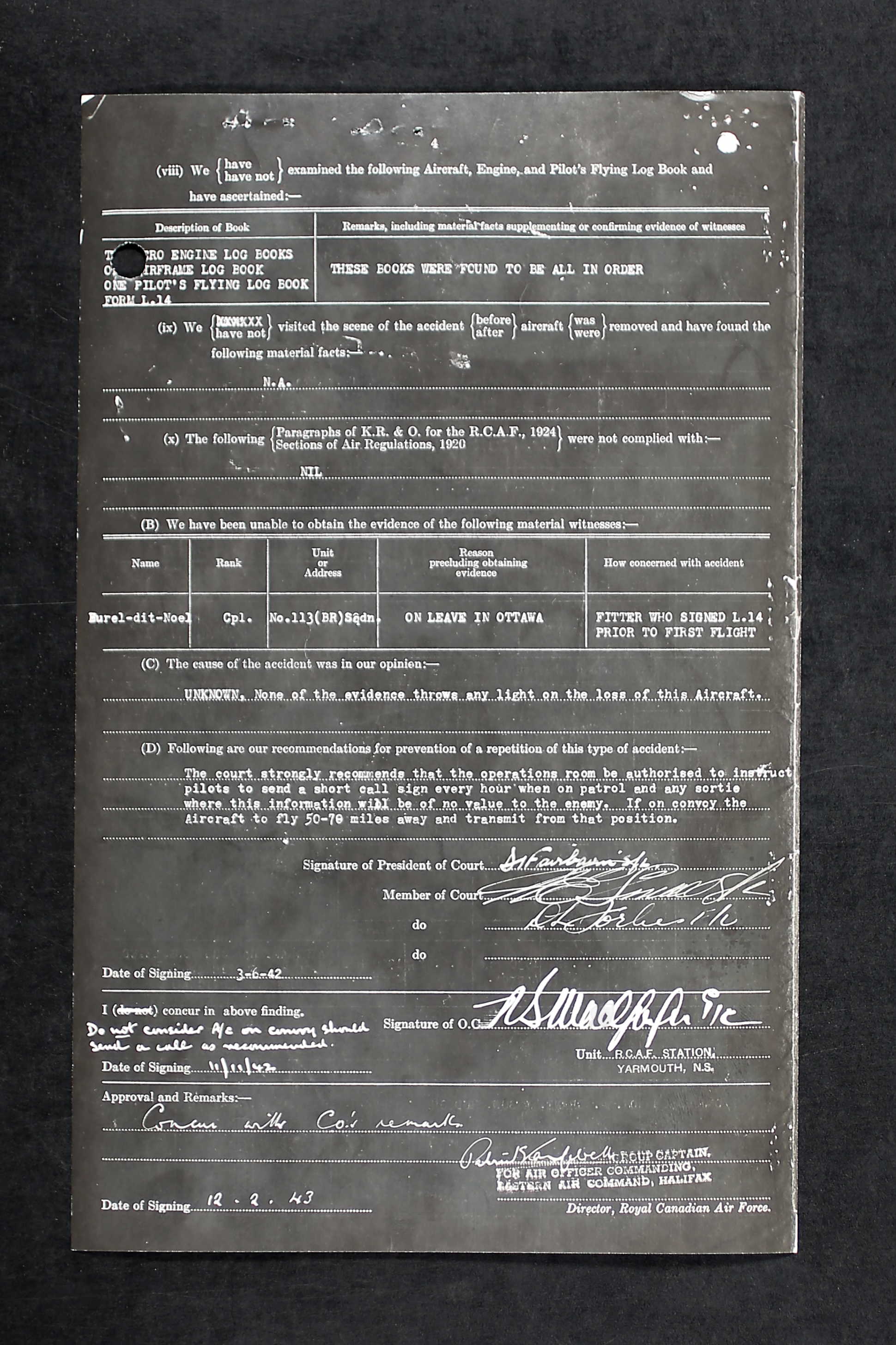
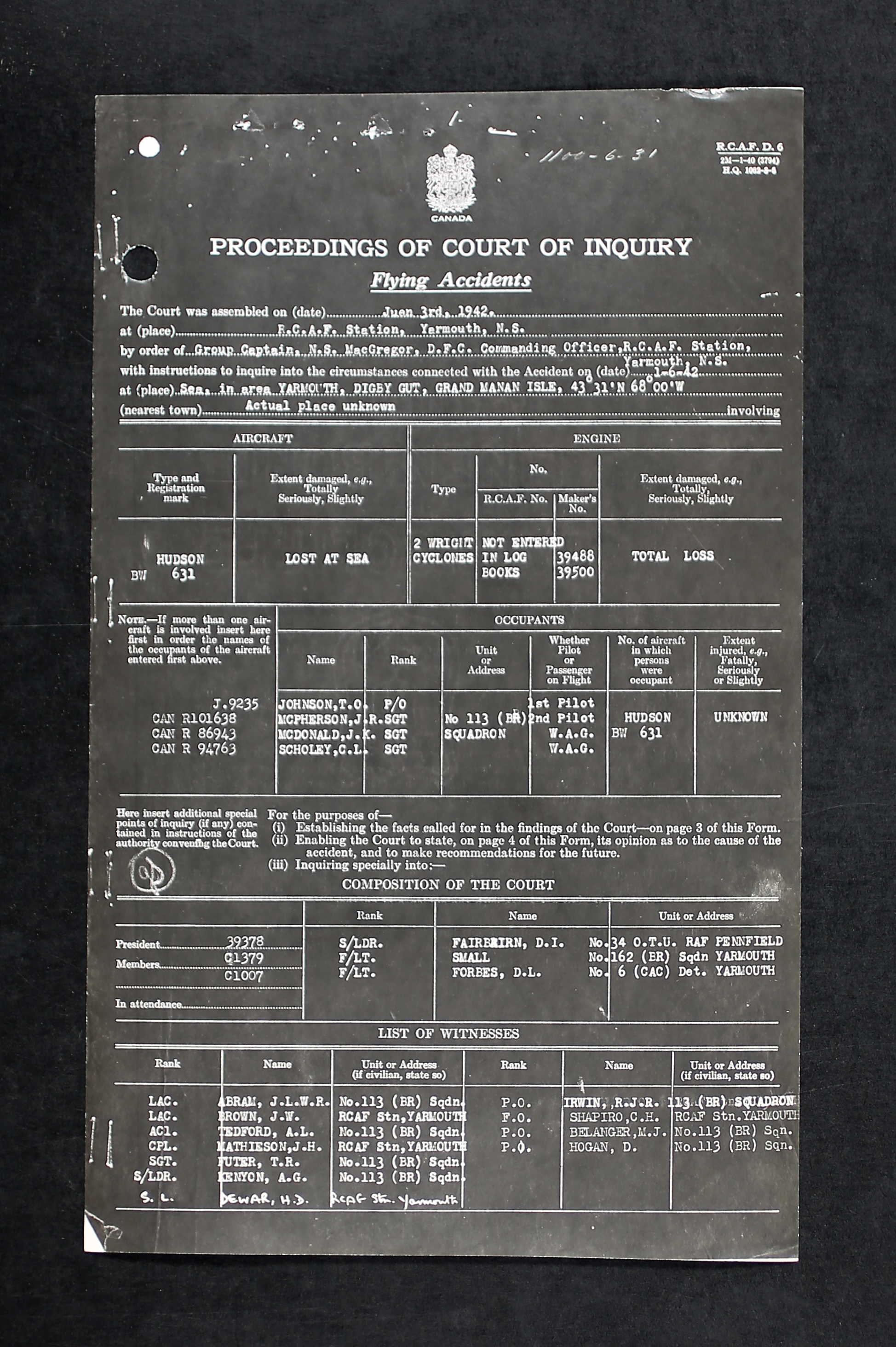
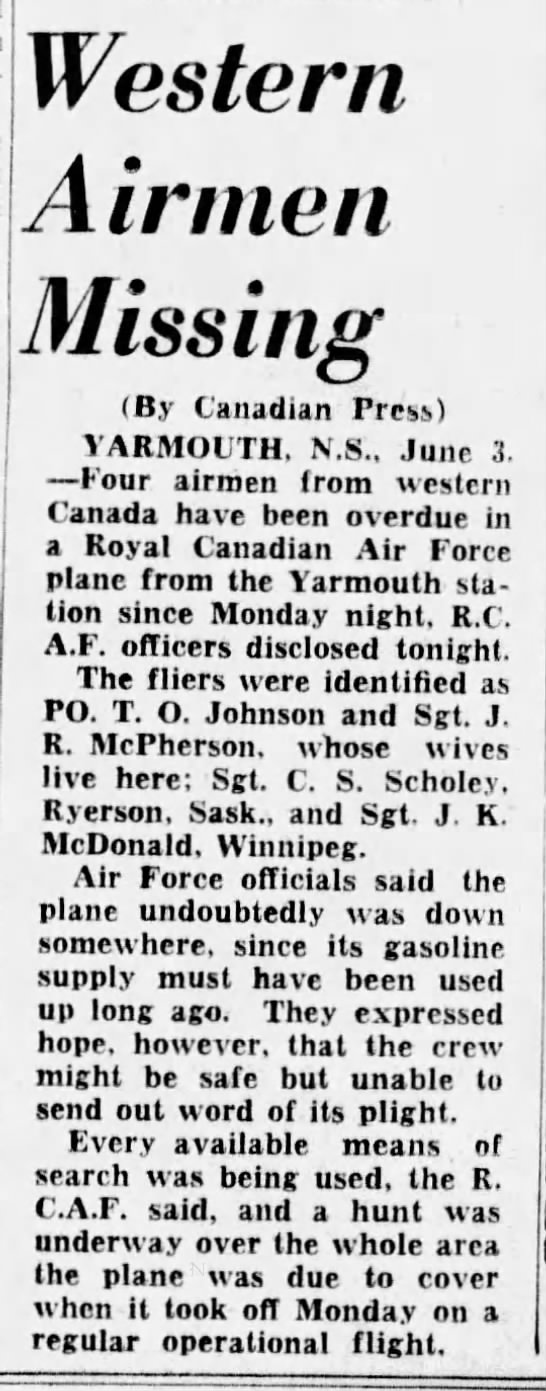
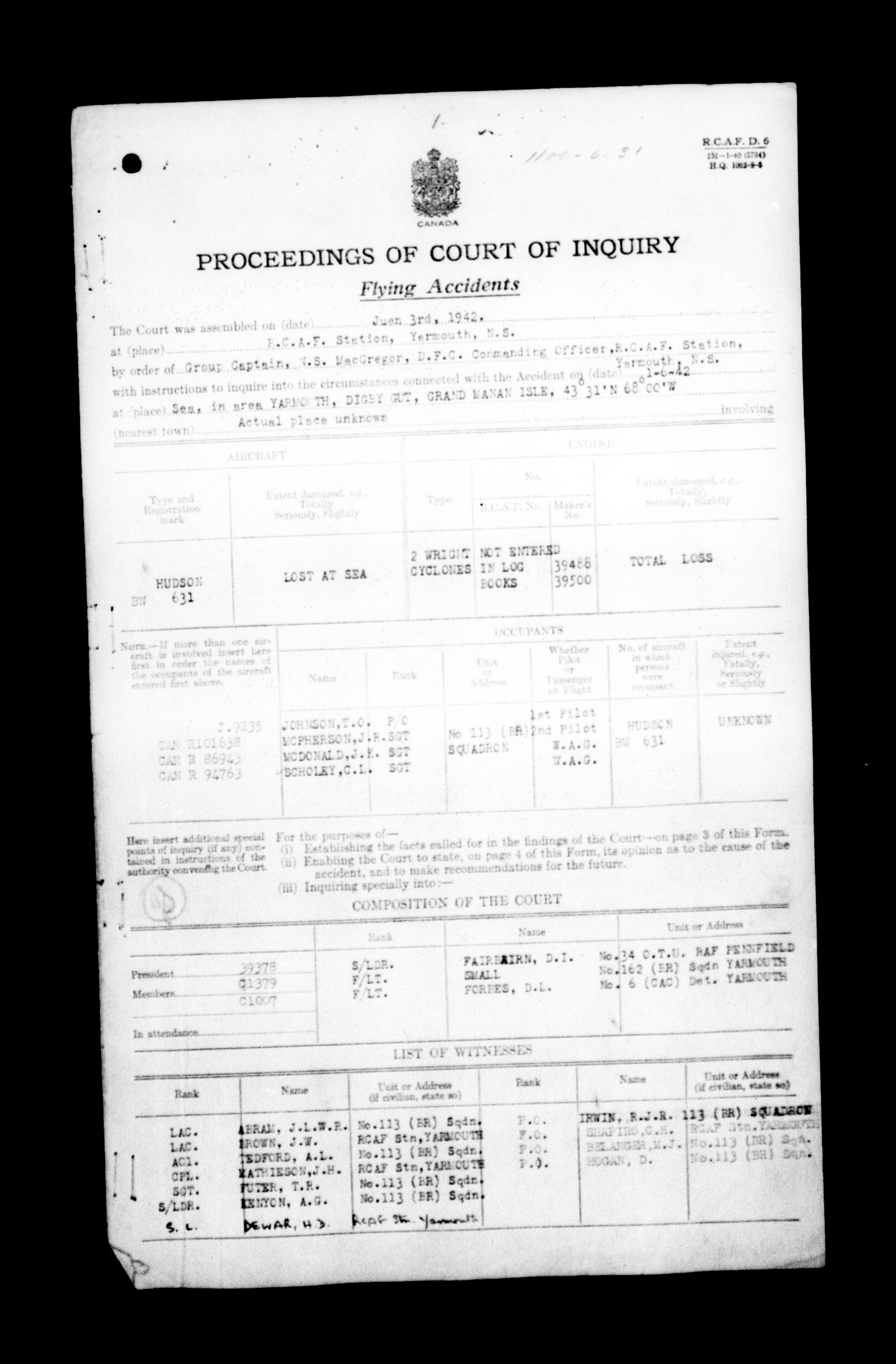
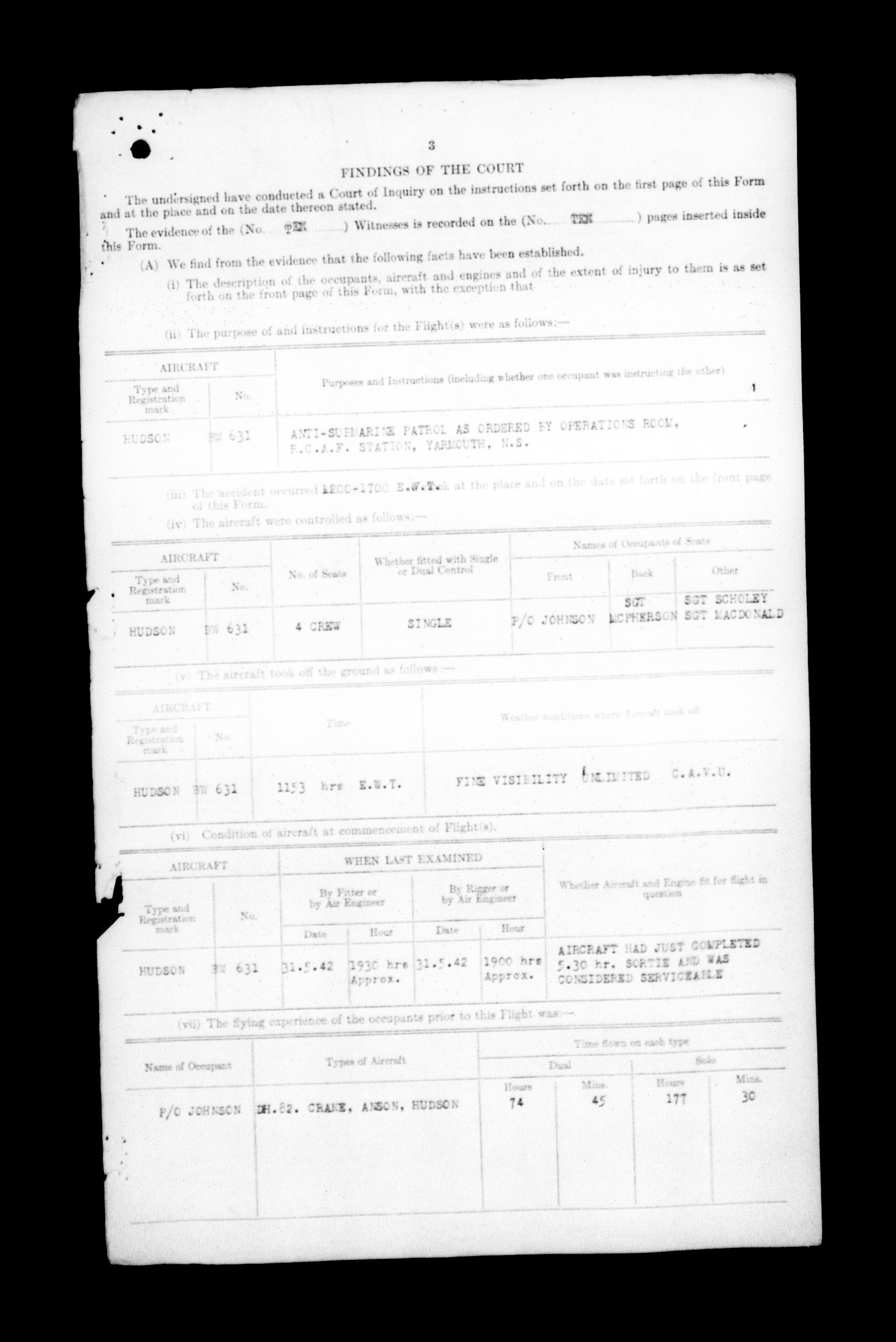
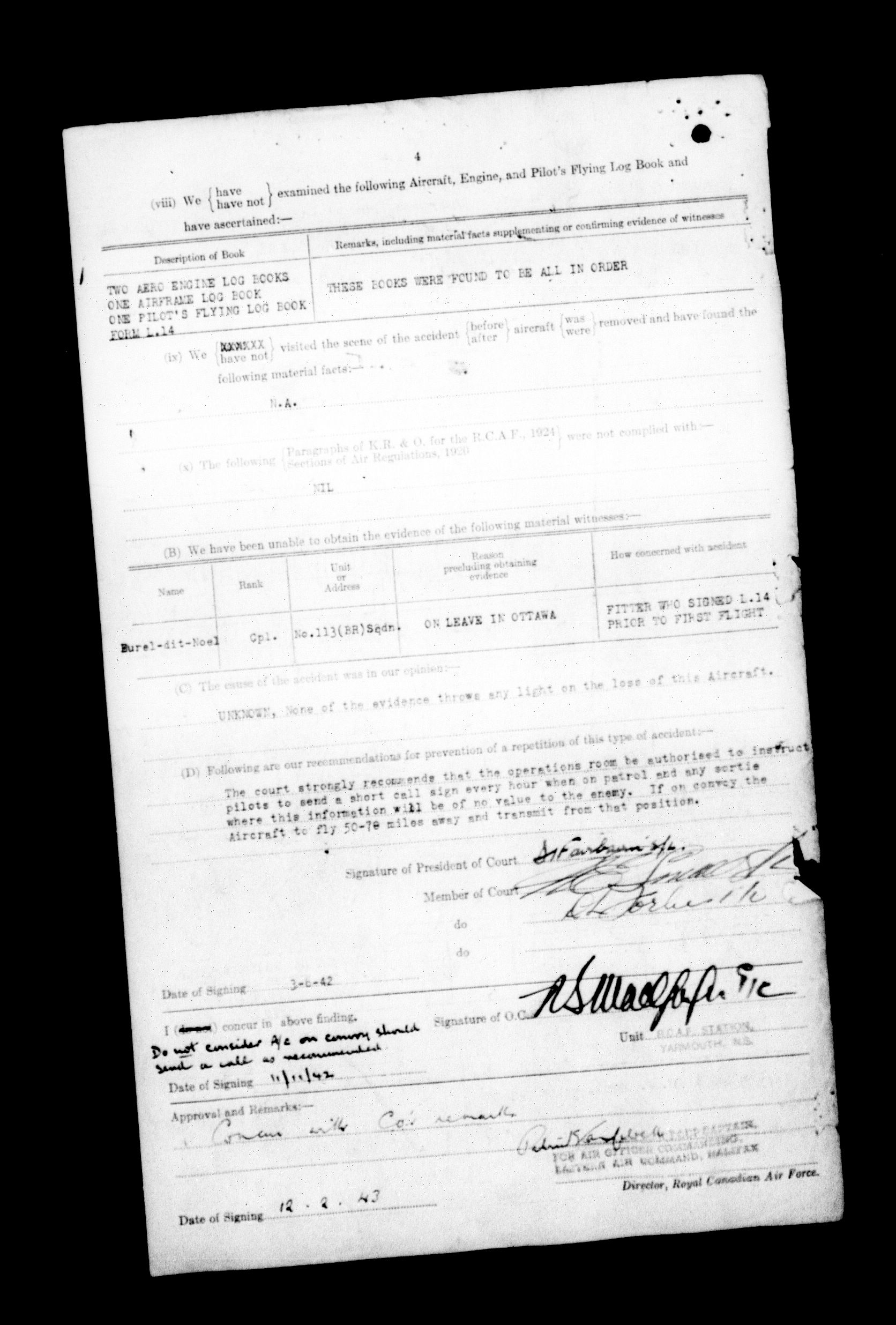
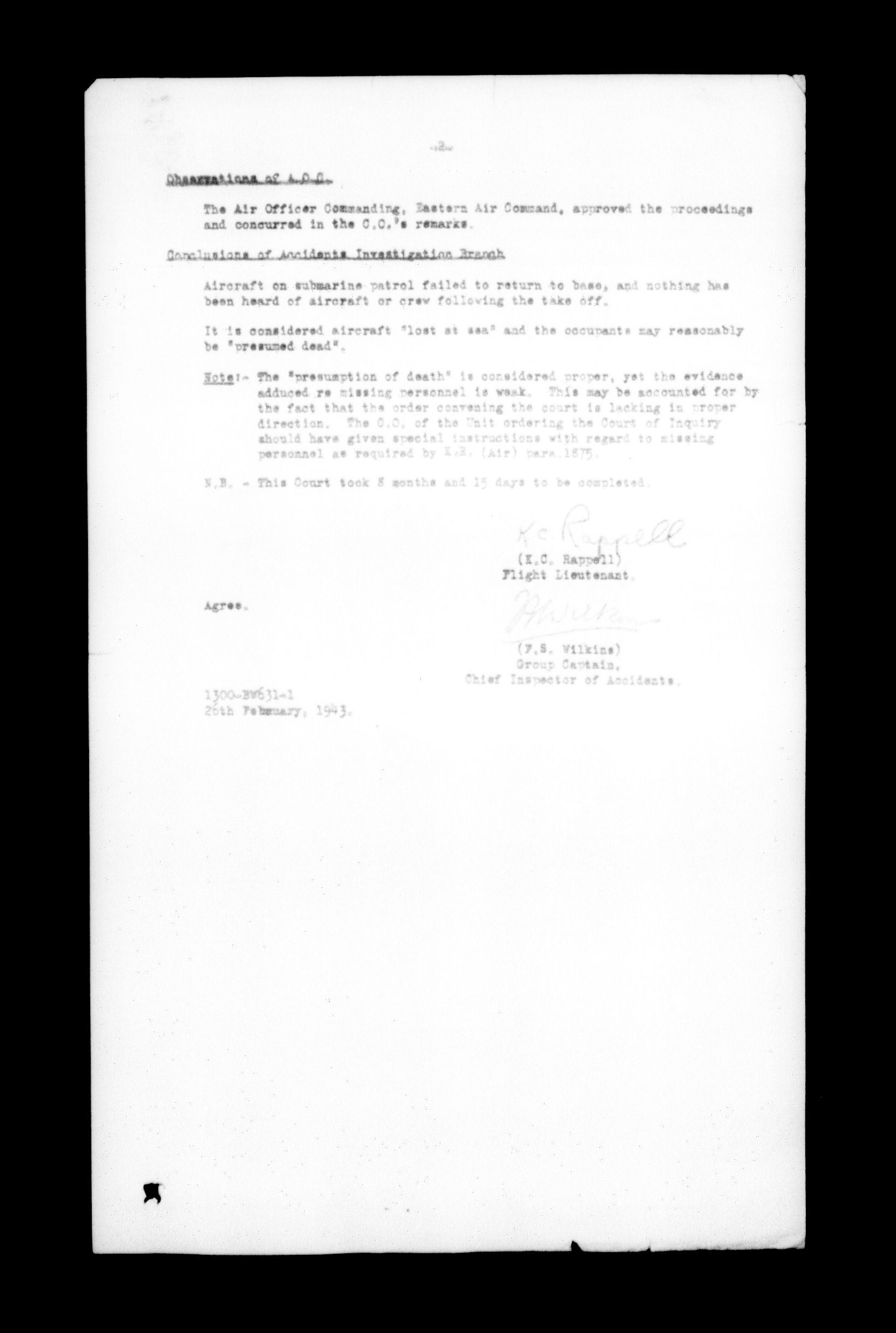
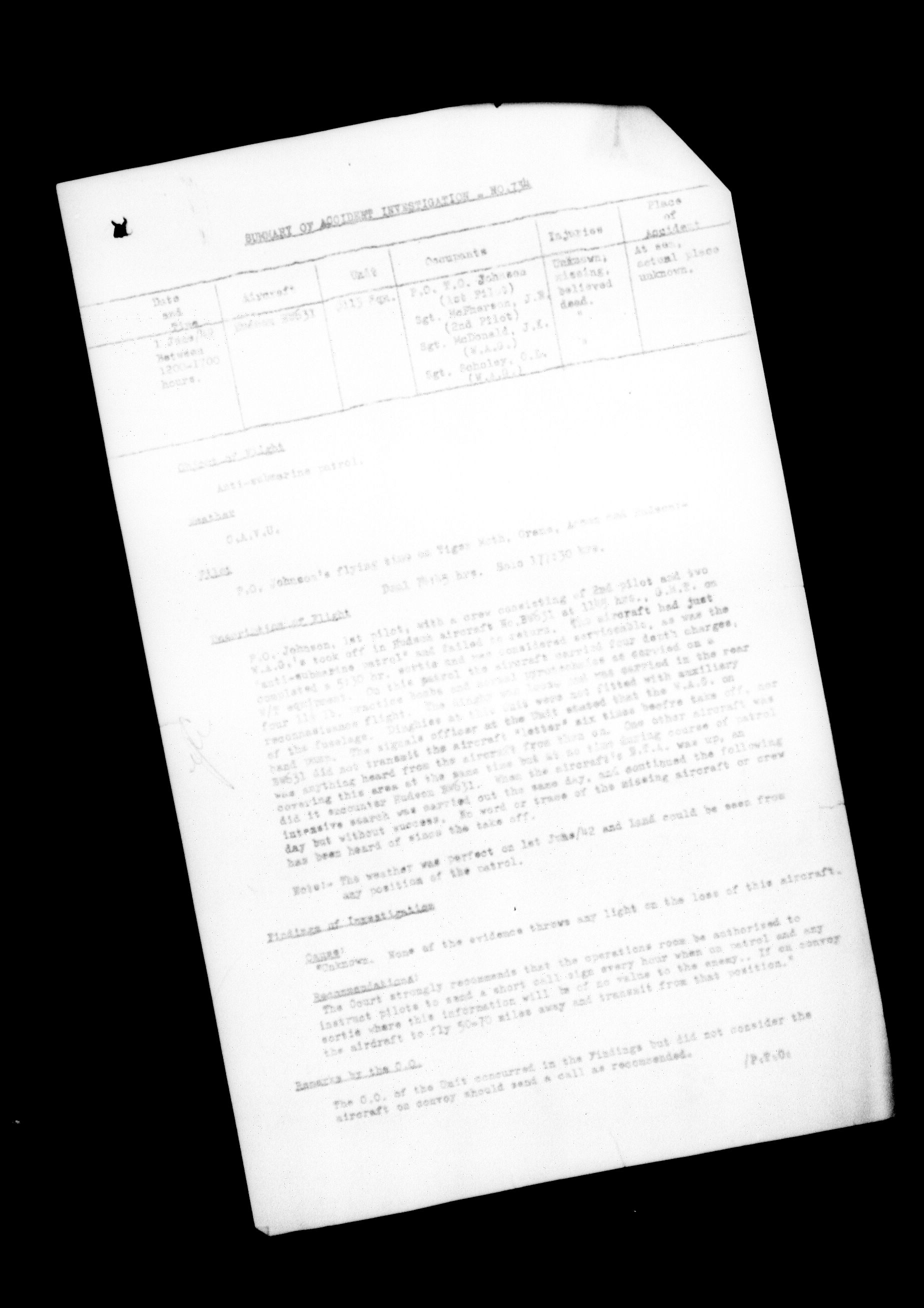

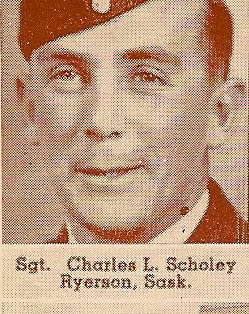

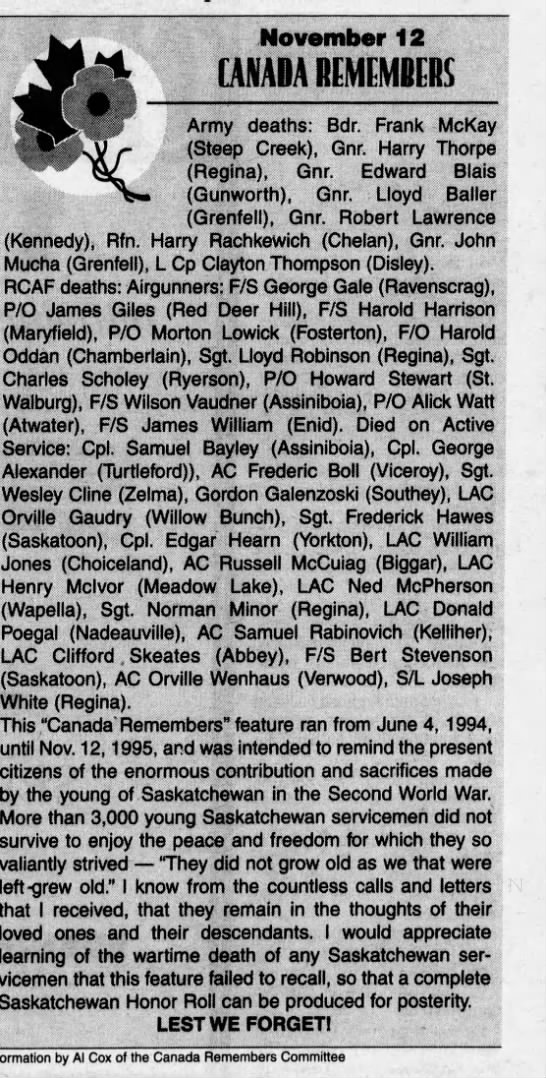
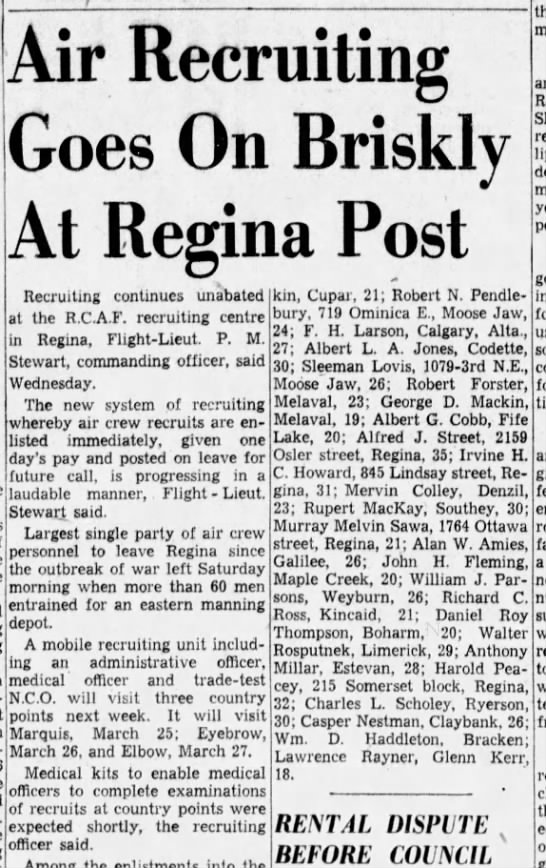
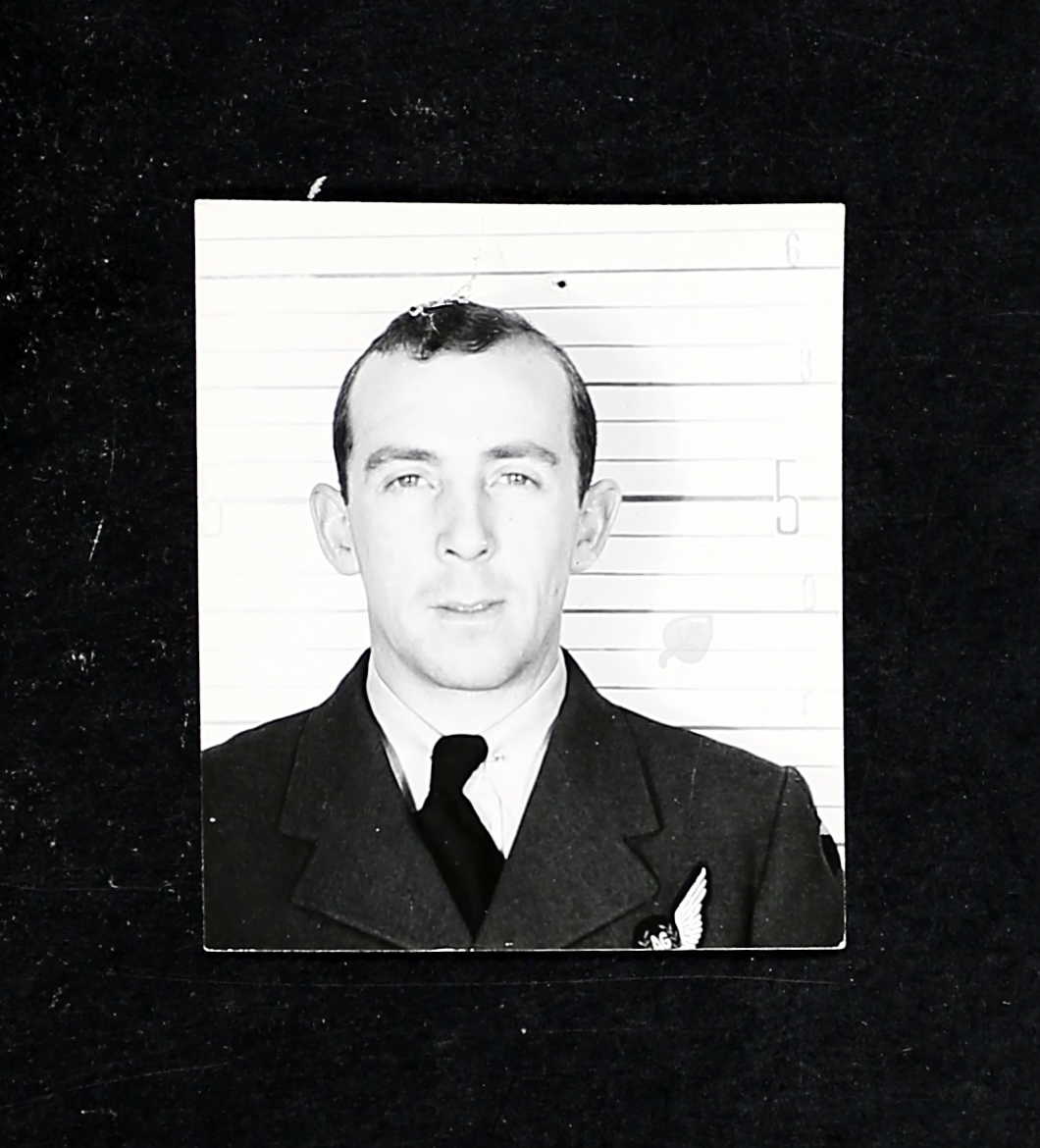

August 13, 1910 - June 1, 1942















Charles Leonard Scholey, born in Astwood, Buckinghamshire, England was the oldest child of Edith (nee Bulmer) Scholey (1882-1964) and Charles Joseph Scholey (1879-1958). He had four sisters, Eunice Emma Scholey (1915-1936), Margaret Helen Johnson (1917-2015), Mary Eva Scholey (b. 1913), and Joyce Elizabeth Scholey (b. 1922), plus one brother, John Bulmer Scholey (b. 1916). The Scholey family arrived in Halifax, Nova Scotia in April 1928, settling in Ryerson, Saskatchewan. Eunice died from a brain tumour. Mary and Joyce were members of CWAC. They attended the Anglican church.
Charles fractured his left ankle when he was a child and fractures three right ribs in 1940. He was a farmer with a Grade X education who enjoyed photography when he enlisted with the RCAF in March 1941. He did not smoke and drank alcohol moderately. He stood 5’ 3¼” tall and weighed 126 pounds. “Short average. Small mole on left clavicle.”
Charles was in debt $230 due October 15, 1941 for the final payment on a separator, $170 due October 20, 1941 final payment on one way disc. “Am leaving my rented farm ¾ section which my brother and father will operate. They should be able to pay these debts out of proceeds of farm.” He added, “With regard to my debts, I believe that satisfactory arrangements can be made.” He indicated that he “had experience in operating and overhauling farm tractors and all other power farming machinery.” He liked to play hockey and softball. He hoped to be a wireless operator/air gunner. Charles was accepted on March 15, 1941 into the RCAF. “Very good type. Very anxious to serve. Healthy and of average appearance.”
At No. 2 Wireless School, Calgary, Alberta, July 21 to December 7, 1941: “Below average. 84th out of 162 in class. 65.4%.” He earned his Wireless Operator’s Badge on April 1, 1942. He was sent to No. 3 B&G School, MacDonald, from January 5 to February 2, 1942. Charles was 13th out of 26. “Good type. Mature and reliable, but not a particularly good student.” He earned his Air Gunner’s badge on April 2, 1942. On July 11, 1941, he forfeited one day’s pay, as he was AWL.
In the Leader-Post, March 19, 1941, Charles was mentioned as an enlistment for “various classifications of the air force” out of Regina. “The new system of recruiting whereby air crew recruits are enlisted immediately, given one day’s pay and posted on leave for future call…largest single party of air crew personnel to leave Regina since the outbreak of war left Saturday morning when more than 60 men entrained for an eastern manning depot.” His name made the list under the headline “GUNNERS RECEIVE BADGES” in the Leader-Post’s issue January 3, 1942. He was remembered in the Saskatoon Sun, November 12, 1995 issue as well.
Charles was sent to Halifax February 14, 1942 and then was posted to 113 BR Squadron, Yarmouth, Nova Scotia.
Hudson BW631 went missing near the mouth of the Bay of Fundy while on an anti-submarine patrol. CREW: FIRST PILOT,Pilot Officer Trask O’Neil Johnson, J9235, RCAF, WAG Sgt Joffre Kitchener McDonald, R86943, RCAF, SECOND PILOT Sgt John Roderick McPherson, R101638, RCAF, and WAG Sgt. Charles Leonard Scholey, R94763, RCAF, all with 113 Squadron, Yarmouth, NS. All men’s names appear on the Ottawa Memorial as they have no known graves.
Eleven witnesses were called during the Court of Inquiry. [Microfiche C5936, Image 1369 and T12340 Image 3345]. The court convened at 0930 hours June 3, 1942 and completed it investigation and findings at 2200 hours the same day, with two adjournments: 1145-1330 and 1700 to 1900 hours.
S/L A. G. Kenyon, Officer Commanding 113 (BR) Squadron, RCAF Yarmouth, Nova Scotia wrote on June 3, 1942 to Air Force HQ, Ottawa: “instructions were received from the Assistant Controller RCAF station, Yarmouth NS, on 1-6-42, foreign aircraft to make a general reconnaissance, beginning 1330 GMT, this time was subsequently changed to 1500 GMT. the patrol detailed was as follows: proceed to Digby Gut, thence to southwest head of Grand Manan Island, and assuming a visibility of five miles, carry out a creeping line ahead patrol, in the area bounded by the following points: 1. Yarmouth, 2. Digby Gut, 3. South west head of Grand Manan Island, 4. 43 35 N 6800 W return to base by 1915 GMT. P/O T. O. Johnson (j9235), Captain, R101638 Sgt. McPherson, JR (Navigator), R94763 Sgt Scholey, C.L, WOAG, R86943 Sgt. McDonald, J.K., WOAG, took off in Lockheed Hudson BW 631 at 1453 GMT and completely disappeared, as no signals were received from them after take-off. An intensive search was organized beginning at 2215 GMT June 1st 1942, Anne continued to 2355 GMT June 2nd 1942, further searches on June 3rd 1942 or cancelled due to weather. Mrs. Johnson and Mrs. McPherson reside in Yarmouth and were advised verbally, next of kin of Sgt. Scholey and Sergeant McDonald were advised by telegram and are being kept posted as to further developments. A court of inquiry was convened on authority of the Commanding Officer Group Captain end. S. MacGregor and is now sitting, a full report will no doubt be forwarded shortly.”
The first witness, LAC Joseph Lewis Wilfred Roland Abram, R81873, rigger at 113 (BR) Squadron stated that he carried out a check and found “everything in order for the first flight,” including a dinghy and emergency rations. “The dinghy was a loose dinghy carried in the rear of the fuselage.”
The aircraft had just completed 5.3 hours sortie and was considered serviceable. The second witness, LAC James William Brown, R67897 electrician, stated that he carried out an inspection on May 31, 1942 and found everything in order. The third witness, AC1 Alfred Lee Tedford, R84841, wireless electrical mechanic also found the airplane’s equipment serviceable.
The fourth witness, Cpl. John Hannah Mathieson, 374A, armourer, stated that he was in charge of arming Hudson BW631. “At approximately 2000 hours, May 31, 1942, I carried out the check on the daily inspection performed by the flight armourers. I found everything in order. The explosives carried on Hudson #631 are: 4-MK Vick depth charges, 4 – 11 ½ pound practice bombs, and normal pyrotechnics as carried on a reconnaissance flight.”
The fifth witness, Sgt. Thomas Richard Futer, R87505, NCO pilot of No. 113 (BR) Squadron stated that he was “captain of Hudson aircraft 631 which carried a patrol sweep from 0540 hours to 1110 hours NES, June 1, 1942. This was the first flight of the day for this aircraft. I carried out my patrol as instructed and am satisfied that the aircraft was in a serviceable condition on the completion of the flight. On the take-off, the W/T equipment was tested by transmitting our call sign to the Yarmouth Station. This transmission was acknowledged.”
The sixth witness, S/L Arthur Gordon Kenyon, C845, OC 113 (BR) Squadron, stated that “I was instructed by the officer in charge operations to detail an aircraft and crew to carry out an anti-submarine patrol as per forms green which I produce…I duly authorized this flight detailing aircraft 631 with the crew consisting of Johnson, McPherson, McDonald, and Scholey. I was satisfied that the pilot and crew were qualified to carry out this mission. The dinghies are inspected every period by maintenance squadron. The dinghies are not equipped with auxiliary hand pumps. These are on the scale of issue but none are available at this station.”
The seventh witness, P/O Richard Joseph Irwin, pilot, certified that Hudson BW631 took off from Yarmouth “on an anti-submarine patrol at 1453 GMT on 1st day of June, 1942 with P/O Johnson as first pilot, Sgt. McPherson as second pilot, and Sgt. McDonald and Sgt. Scholey as Wireless Air Gunners. The weather over the patrol area was CAVU during the whole day. One other aircraft was covering this area at the same time but at no time during the course of patrol did it encounter the missing a/c.”
The eighth witness, F/O Clarence Harris Shapiro, C8896, Officer in charge of W/T, stated that “a w/t watch was kept at Yarmouth on all bands on which Hudson BW631 could have transmitted during 1-6-42. The WAG on BW631 did not transmit the a/c letter six times before take-off, nor was anything heard from the a/c from then on.”
The ninth witness, P/O Maurice John Belanger, J10432, Nav Officer stated “all a/c on patrol can obtain D/F bearings from Rockville near Yarmouth or a/c can use Yarmouth Broadcasting Station for homing. As the weather on June 1, 1942 was perfect, there should have been no need for this as the pilot could see land from any position of his patrol.”
The tenth witness, P/O Deryck Hogan, J9122, pilot, stated that “three a/c carried out a search in the same area as a/c BW631 was lost from 2215 hours GMT 1-6-62 to 0210, third a/c returned at 0420 hours GMT 2-6-42. At first light, at 0820 hours GMT, three a/c continued search and this number of a/c continued throughout that day until dark without result. Visibility was reduced to two miles during 2-6-42 and various reports were followed up without result.”
Squadron Leader Douglas Dewar Howard, C1136, was the final witness called. He was the assistant controller at Yarmouth. “Hudson aircraft BW631 from 113 (BR) Squadron took off base on patrol at 1415 GMT June 1, 1942, and did not return. An intensive search was carried out, but no trace of the missing aircraft or its occupants could be found at the time and no word has been received from them since.”
Recommendations: “The court strongly recommends that the operations room be authorized to instruct pilots to send a short call sign every hour when on patrol and any sortie where this information will be of no value to the enemy. If on convoy, the aircraft to fly 50-70 miles away and transmit from that position.”
Engine logbooks were found to be all in order. “Cause of accident: UNKNOWN. None of the evidence throws any light on the loss of this aircraft. The court strongly recommends that the operations room be authorized to instruct pilots to send a short call sign every hour when on patrol and any sortie where this information will be of no value to the enemy. If on convoy, the aircraft to fly 50-70 miles away and transmit from that position.” The CO of RCAF Station, Yarmouth: “Do NOT consider a/c on convoy should send a call as recommended.”
In a memo dated February 27, 1943: “This matter of transmitting call signs every hour has been raised before and has been turned down. The signals procedure now is vogue pretty well airtight, if followed correctly. No action to be taken on this recommendation.”
Mrs. Scholey wrote to F/L W. R. Gunn, in Ottawa, November 27, 1942: “In reply to your letter, I am sorry to tell you we have not any news of our son. I wish we could hear of him. We are still hoping he will come home again. I expect there are many whose boys are missing but I am afraid it does not make our loss any easier, he was always such a good fellow to us and it is impossible for us to forget him. Thanking you for your letter.”
A letter dated February 23, 1943 written by Mrs. Scholey: “I have received my son’s suitcase and parcel for which I thank you. Quite a lot of his belongings are missing and I was very disappointed you did not send anything he had from the Air Force. I did think you would have sent his badge, if nothing more. I think all mothers and wives would like to have them. What became of all of his papers and did you find any English money. I know he had some. I have it to him expecting he was going to England. I have not had any word regarding his money and I should be glad to hear about it soon as possible.”
Charles is also remembered on his family’s headstone at the Fairlight Cemetery, Estevan, Saskatchewan. A lake is also named in his honour.